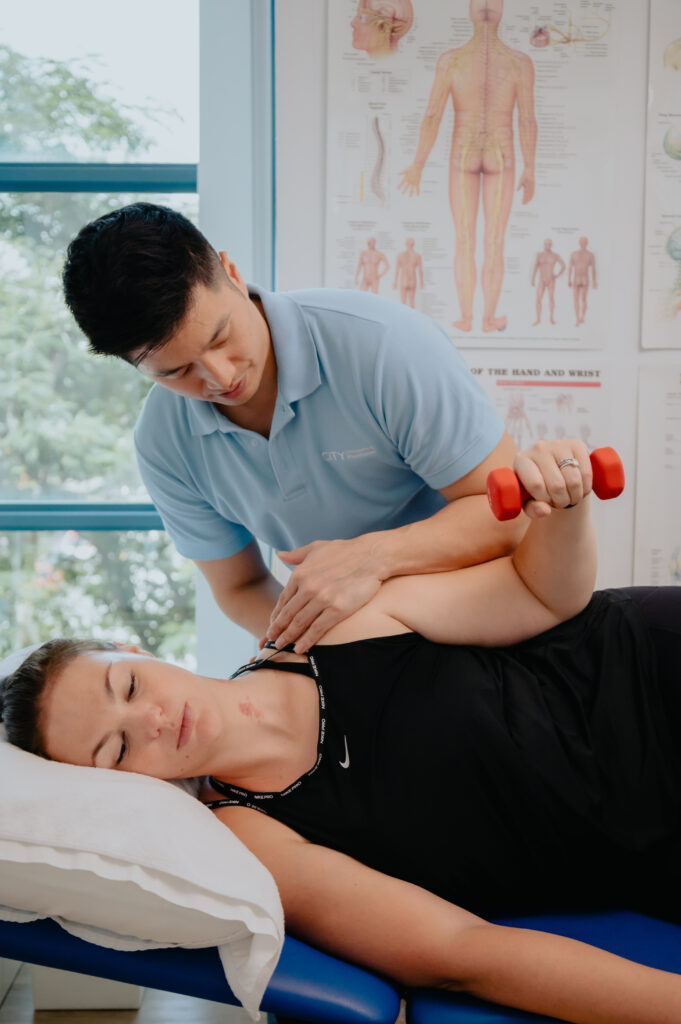
Dry needling is used to address conditions such as plantar fasciitis, carpal tunnel syndrome, and tension headaches. Dry needling can also help to break up scar tissue and increase blood flow to the area.
Get to the root of your pain, naturally.
Dry needling is a type of acupuncture modality that uses needles to relieve pain. It involves inserting thin needles into the skin. It is thought that dry needling works by causing the release of chemicals that help relieve pain. It can also help to reduce muscle tension.
Dry needling is used to address conditions such as plantar fasciitis, carpal tunnel syndrome, and tension headaches. Dry needling can also help to break up scar tissue and increase blood flow to the area.


The benefits of dry needling include pain relief and improved blood flow. Dry needling can help to reduce muscle tension and break up scar tissue. It is also thought to stimulate the release of chemicals that help relieve pain.
Dry needling is generally considered safe and is an effective modality for many people. However, as with any modalities, there are potential risks and side effects, such as a risk of bruising, bleeding, and infection. There is also a small risk of puncturing the skin.
If you are interested in dry needling, it is important to consult with a qualified practitioner to ensure that it is the right method for you.
Dry needling is most commonly used to address musculoskeletal pain and tension. It can provide relief from conditions such as plantar fasciitis, carpal tunnel syndrome, and tension headaches. It may also be helpful for those with chronic pain, sports injuries, and scar tissue adhesions. Dry needling can also be used to improve blood flow and promote relaxation.
Additionally, it can be used to help people with fibromyalgia, myofascial pain syndrome, and other chronic conditions. Dry needling is typically safe for most people but should be performed by a qualified practitioner. It is always important to talk to your doctor before beginning any care plan.
Dry needling is an effective way to address plantar fasciitis. It can help reduce pain and inflammation in the tissue surrounding the heel. The needles are inserted into specific points around the foot, which helps to break up scar tissue and improve blood flow. This increases the circulation of oxygen and nutrients, helping the body heal itself.
Dry needling can also help reduce muscle spasms, which can further relieve pain and improve mobility. In some cases, dry needling may be combined with physical therapy or therapeutic ultrasound to provide additional relief.
Carpal tunnel syndrome is a condition caused by compression of the median nerve. Dry needling may be an effective way to address it, as it can help to reduce inflammation and improve circulation in the affected area.
The needles are inserted into specific points around the wrist, forearm, and elbow. This helps to relax tight muscles and increase blood flow to the area, which can help reduce pain and improve mobility.
Dry needling may also be combined with other methods, such as wrist splints or physical therapy, for additional relief.
Dry needling is an effective way to address migraines. It works by relieving muscle tension, which is often a cause of migraines. The needles are inserted into specific points around the head, neck, and shoulders to help relax the muscles and reduce pain. Dry needling can also help improve blood flow in these areas, which may also provide relief from migraine symptoms.
In addition to treating migraines, dry needling is also used to treat tension headaches. Dry needling helps to reduce muscle tension in the neck and shoulders, which can ease pain and improve mobility. It may also help increase blood flow to these areas, which can further reduce pain and promote relaxation.
Dry needling is a safe and effective method for chronic pain conditions such as fibromyalgia and myofascial pain syndrome.
Fibromyalgia is a chronic condition characterized by widespread pain and tenderness across the body. It often leads to fatigue and can cause a range of other symptoms such as insomnia, headaches, and depression. Fibromyalgia is thought to be caused by changes in the way the brain processes pain signals from the nerves. While the exact cause of fibromyalgia is still unknown, dry needling can be an effective way to manage the condition. The needles are inserted into specific points along the body that are known to help reduce pain and inflammation. It also helps to improve blood flow and oxygenation, which can reduce fatigue and promote relaxation.
Myofascial pain syndrome (MPS) is a chronic condition that affects the muscles and connective tissues. It is characterized by muscle pain, tenderness, and stiffness. While MPS does not have an exact cause, dry needling can help to reduce pain and improve mobility. The needles are inserted into specific points in the affected areas, which helps to relax tight muscles and break down scar tissue. This can help to reduce pain and improve flexibility.
Dry needling and acupuncture are two different techniques that involve the insertion of thin needles into the body, but they have distinct origins and purposes.
In summary, while both dry needling and acupuncture involve the use of thin needles, dry needling focuses on releasing muscle trigger points to relieve musculoskeletal pain, while acupuncture aims to restore energy balance within the body to promote general well-being and treat various health conditions.
Dry needling can cause some discomfort or pain during the treatment, but the level of pain can vary depending on individual sensitivity, the areas being treated, and the skill of the practitioner. Here are a few points to consider:
It’s important to communicate with your healthcare professional during the dry needling session. They can adjust the treatment technique or needle placement if the discomfort is excessive. Additionally, they can provide guidance on managing any post-treatment soreness or discomfort that may arise
After dry needling, you may experience muscle soreness or tenderness at the treated areas, which can persist for a few hours or days. This soreness is typically similar to post-exercise muscle soreness and is considered a normal part of the healing process.
While it’s rare, headaches can be an occasional side effect of dry needling. The process involves inserting thin needles into specific trigger points or tight muscles to alleviate pain and promote healing. However, any discomfort experienced during or after dry needling is usually temporary and subsides quickly. If you do experience persistent headaches or any unusual symptoms, it’s important to consult your healthcare provider for proper evaluation and guidance.
Consulting an osteopath or physiotherapist is beneficial as they can assess the severity and stage of your frozen shoulder. They can provide valuable insights into your condition, suggest appropriate modifications or ergonomic adjustments to reduce strain on your shoulder while working, and advise on exercises and stretches that can help maintain or improve shoulder mobility.
By working closely with an osteopath or physiotherapist, you can gain a better understanding of your limitations and prevent further injury by not overexerting your shoulder. They can provide specific recommendations tailored to your work requirements and help you develop strategies to manage your tasks effectively while minimising discomfort.
Remember, open communication with your employer is crucial. Inform them about your frozen shoulder and discuss possible modifications or adaptations to your work environment that can support your recovery. With the right accommodations and professional guidance, you can navigate your work responsibilities while giving your shoulder the necessary care and attention it needs.
Dry needling typically does not cause any severe after-effects. However, it’s common to experience mild soreness or bruising at the needle insertion sites, which should subside within a day or two. It’s advisable to keep the treated areas clean and avoid any vigorous activities or excessive stretching immediately after the session to prevent further discomfort. It’s also essential to follow the post-treatment instructions provided by your physiotherapist to ensure a smooth recovery and achieve the best results.
*Please note that the information provided in this FAQ is for general knowledge purposes only and should not substitute professional medical advice. If you have specific concerns or questions regarding dry needling, it’s always recommended to consult a qualified healthcare professional.
Have the best experts in osteopathy, physiotherapy, and massage therapy services work together to tailor a unique care plan for you.
Everything you need to get better, under one roof.

We are here with you at every step of the way.
We evolve, grow, and flex as you and your body does.

The initial examination & diagnosis to get to know you and your body.

Our expert recommendation to get you from where you are, to the better you.

The most relevant experts employ hands-on therapy & corrective exercises for an effective healing journey.

You are ever-evolving & so will your recovery plan. Our experts consistently reassess your condition & progress, updating our approach and methods.
Address: 1 Gateway Drive, Westgate Tower, #10-13 S(608531)
Contact us: Whatsapp
Opening hours:
Wednesday: 8 am to 8 pm
Thursday – Tuesday: Closed
Already a patient with us? Book your return visit here.
Or need help deciding on a service or practitioner? Message us here.